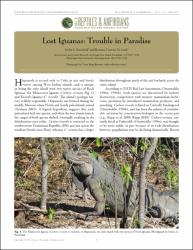/admin/item?itemID=e9e51b8e-30d3-4a6a-af1b-8f13252a0afb
Lost iguanas : trouble in paradise

Ver/
Tipo de acceso
AbiertoTipo de Material
ArtículoTipo de Contenido
Investigación científicaIdioma
InglésAudiencia
Técnicos, profesionales y científicosColección
- Investigación ambiental [1693]
Metadatos
Mostrar el registro completo del ítem| Sinopsis: | Hispaniola is second only to Cuba in size and biodiversity among West Indian islands, and is unique in being the only island with two native species of Rock Iguanas, the Rhinoceros Iguana (Cyclura cornuta) and Ricord’s Iguana (C. ricordii). The island’s geologic history is likely responsible. Hispaniola was formed during the middle Miocene when North and South paleoislands joined (Graham 2003). A logical hypothesis suggests that each paleoisland held one species, and when the two islands joined, the ranges of both species shifted, eventually resulting in the distributions seen today. Cyclura ricordii is restricted to the southwestern Dominican Republic and just across the southern border into Haiti, whereas C. cornuta has a larger distribution throughout much of the arid lowlands across the entire island. |
| Autor(es): | Pasachnik, Stesha A.
Carreras de León, Rosanna |
| Año: | 2014 |
| Publicado: | Reptiles & Amphibians [2332-4961[, 21(1), 1-8 |
| Citación: | Pasachnik, S. A., & Carreras de León, R. (2014). Lost iguanas: trouble in paradise. Reptiles & Amphibians, 21(1), 1-8. Recuperado de: |
| URI: | https://bvearmb.do/handle/123456789/1057
|

